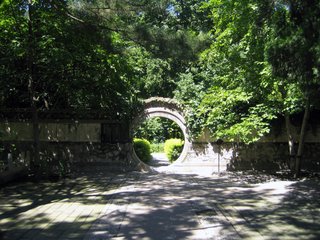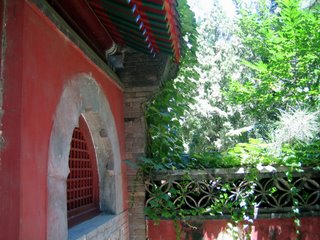Tanzhe Si

Tanzhe Si (rather picturesquely translated as "The Temple of the Pool and the Wild Mulberry") is a typical Buddhist temple, located in the Tanzhe Hills on the western outskirts of Beijing, about a 1 or 2 hour drive by taxi from BCLU. Apparently, it was the first temple that appeared in the Beijing area, ever. When the temple was built during the Jin Dynasty (AD265- 420), Buddhism began to spread in the area southwest of present- day Beijing, later known as
 Youzhou, giving rise to the a saying that "First there was the Tanzhe Temple, then there was Beijing."
Youzhou, giving rise to the a saying that "First there was the Tanzhe Temple, then there was Beijing."According to this website, Buddhism was introduced into China during the Eastern Han Dynasty (AD 25-220). Temples were built throughout the country. The places where images of Buddha were enshrined and eminent monks from India stayed were regarded as sacred places like government offices. As the saying goes, "There were 480 temples during the Southern Dynasties. Many famous mountains were occupied by monks." Cast during the reign of Emperor Chenghua of the Ming Dynasty, the bell at the Tanzhe Temple is 0.47metre in height, 0.31 meter in rim diameter and 24.8 kilograms in weight. On the waist of the bell is an inscription of seal characters which means that the bell was made uring the reign of Chenghua of the Ming Dynasty. It is decorated with fret patterns and a design of two dragons laying with a pearl. The exquisite bell is a proof of the renovation and extension of the Tanzhe Temple to the present cale at the end of the 17th century.
We were accompanied in our trip to the temple by the old, rich architect who gave us our tour of
 the construction areas on the first day of our trip. I made the mistake of asking him to explain his take on the Chinese architectural/design principle of feng shui, and so was treated all trip long to cries of "He Kaili! Lai, lai..." ("Kelly! Come here, I want to show you...."). He was a funny sort of man. He reminded me in a lot of ways of certain middle-aged, very self-satisfied men I've known in the US. He was fond of taking us all out for lunch and ordering far more food than the group could ever eat, of monopolizing conversation to share his wisdom and ideas, and of making sweeping pronouncements and jokes with the easy confidence of a rich man in a land where so many have so little.
the construction areas on the first day of our trip. I made the mistake of asking him to explain his take on the Chinese architectural/design principle of feng shui, and so was treated all trip long to cries of "He Kaili! Lai, lai..." ("Kelly! Come here, I want to show you...."). He was a funny sort of man. He reminded me in a lot of ways of certain middle-aged, very self-satisfied men I've known in the US. He was fond of taking us all out for lunch and ordering far more food than the group could ever eat, of monopolizing conversation to share his wisdom and ideas, and of making sweeping pronouncements and jokes with the easy confidence of a rich man in a land where so many have so little.My second mistake of the
 trip was wearing my cute new espadrilles, which were very cumbersome seeing as the second part of our trip involved crossing a stream bed (yes, by leaping from rock to rock -- I removed the shoes) and then hiking a rough trail to a more hidden temple area and some scenic outcroppings. The trail was beautiful, though... well worth the inconvenience. My third mistake was to ask my teachers a question about the process of prostrating yourself before Buddha. In a flurry of excitement they ushered me over to the temple's main monk, proud to have a student with a question. Embarrassed, I stumbled out my question before the man in maroon robes, who gave me an answer I couldn't understand while fingering his string of wooden beads and staring at the ceiling.
trip was wearing my cute new espadrilles, which were very cumbersome seeing as the second part of our trip involved crossing a stream bed (yes, by leaping from rock to rock -- I removed the shoes) and then hiking a rough trail to a more hidden temple area and some scenic outcroppings. The trail was beautiful, though... well worth the inconvenience. My third mistake was to ask my teachers a question about the process of prostrating yourself before Buddha. In a flurry of excitement they ushered me over to the temple's main monk, proud to have a student with a question. Embarrassed, I stumbled out my question before the man in maroon robes, who gave me an answer I couldn't understand while fingering his string of wooden beads and staring at the ceiling.The teachers (and architect, who by this time seemed to think of himself as a
 kind of personal mentor to me) explained the process, which was actually quite interesting -- my question regarded the reasoning behind the placement of the hands during the worshipping, which is apparently meant to symbolize offering your xin (heart and mind, all inner thoughts) to the Buddha, laying open your sould in reverence for him. "Now you try it, now you try it, Kaili," my teachers bubbled after I had suffered through this somewhat awkward exchange with the monk -- compounding an already sufficiently embarrassing situation. "Hao," I agreed, somewhat reluctantly, and, with the entire class looking on, performed the ceremony of prostrating myself three times with ritual hand gestures before Buddha. It was certainly interesting, though I think I might have preferred to do it without everyone else looking on.
kind of personal mentor to me) explained the process, which was actually quite interesting -- my question regarded the reasoning behind the placement of the hands during the worshipping, which is apparently meant to symbolize offering your xin (heart and mind, all inner thoughts) to the Buddha, laying open your sould in reverence for him. "Now you try it, now you try it, Kaili," my teachers bubbled after I had suffered through this somewhat awkward exchange with the monk -- compounding an already sufficiently embarrassing situation. "Hao," I agreed, somewhat reluctantly, and, with the entire class looking on, performed the ceremony of prostrating myself three times with ritual hand gestures before Buddha. It was certainly interesting, though I think I might have preferred to do it without everyone else looking on.Grumbling aside, this really was a wonderful trip, and I think Tanzhe Si is probably one of my favorite places
 I've been in China so far. The Lama Temple, while also beautiful, did not have the kind air of sacredness and timelessness that this place had. The hazy mountains in the distance, the serene Buddhist architecture, the careful placement of trees and stones in the courtyard full of worshippers, the quiet trails on the side of the mountain and the soft splashing of the brook outside the temple's eastern wall -- all combined to form what I learned was, for a number of reasons, incredible feng shui, which began with the naturally good energies of the location (with mountains shaped like a sleeping dragon to the north and a broad stretch of lazy river water to the south) and was carefully enhanced architecturally with respect for the feng shui of the underlying landscape. You could really imagine monks finding an inner peace at this temple, of sitting quietly as one with the air, water, and earth around them, and thinking up the deeply profound poetry of the Tao Te Ching (Dao De Jing).
I've been in China so far. The Lama Temple, while also beautiful, did not have the kind air of sacredness and timelessness that this place had. The hazy mountains in the distance, the serene Buddhist architecture, the careful placement of trees and stones in the courtyard full of worshippers, the quiet trails on the side of the mountain and the soft splashing of the brook outside the temple's eastern wall -- all combined to form what I learned was, for a number of reasons, incredible feng shui, which began with the naturally good energies of the location (with mountains shaped like a sleeping dragon to the north and a broad stretch of lazy river water to the south) and was carefully enhanced architecturally with respect for the feng shui of the underlying landscape. You could really imagine monks finding an inner peace at this temple, of sitting quietly as one with the air, water, and earth around them, and thinking up the deeply profound poetry of the Tao Te Ching (Dao De Jing).In fact, I think I'll leave you with one of my favorite verses from the book, which I'm reading in my spare time (what spare time?). The first verse:
道可道,非常道。
名可名,非常名。
无名天地之始。
有名万物之母。
故常无欲以观其妙。

常有欲以观其徼。
此两者同出而异名,同谓之玄。
玄之又玄,众妙之门。
There are ways but the Way is uncharted;
There are names but not nature in words:
Nameless indeed is the source of creation
But things have a mother and she has a name.
The secret waits for the insight
Of eyes unclouded by longing;
Those who are bound by desire
See only the outward container.
These two come paired but distinct
By their names.
Of all things profound,
Say that their pairing is deepest,
The gate to the root of the world.
(Trans. R. B. Blakney)


<< Home